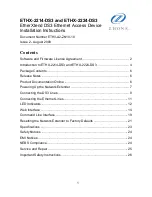
1-4
•
Inductance coupling.
•
Electromagnetic wave radiation.
•
Common impedance (including the grounding system) coupling.
To prevent EMI, perform the following tasks:
•
If AC power is used, use a single-phase three-wire power receptacle with protection earth (PE)
to filter interference from the power grid.
•
Keep the device far away from radio transmitting stations, radar stations, and high-frequency
devices.
•
Use electromagnetic shielding, for example, shielded interface cables, when necessary.
Grounding
Using a good grounding system to protect your device against lightning shocks, interferences, and
ESD is essential to the operating reliability of your device.
Make sure the equipment room grounding system has a resistance value less than 1 ohm.
For more information about grounding the device, see "Installing the device."
Power
Perform the following tasks to meet the power requirements:
1.
Calculate the system power consumption.
The system power consumption varies by card type and density. For more information about
system power consumption calculation, see
H3C S12500R Switch Router Series Hardware
Reference
.
2.
Identify the number of power modules.
The total maximum output power of all power modules must be higher than the system power
consumption. For more information about available power modules, see
H3C S12500R Switch
Router Series Hardware Reference
.
3.
Verify that the power system at the installation site meets the requirements of the power
modules, including the input method and rated input voltage. For more information about power
module specifications, see
H3C S12500R Switch Router Series Hardware Reference
.
Cooling
Plan the installation site for adequate ventilation:
•
Leave a minimum of 30 cm (11.81 in) of clearance at the inlet and outlet air vents.
•
The rack for the device has a good cooling system.
•
The installation site has a good cooling system.
•
Verify that the airflow design of the chassis meets the airflow design of the installation site.











































